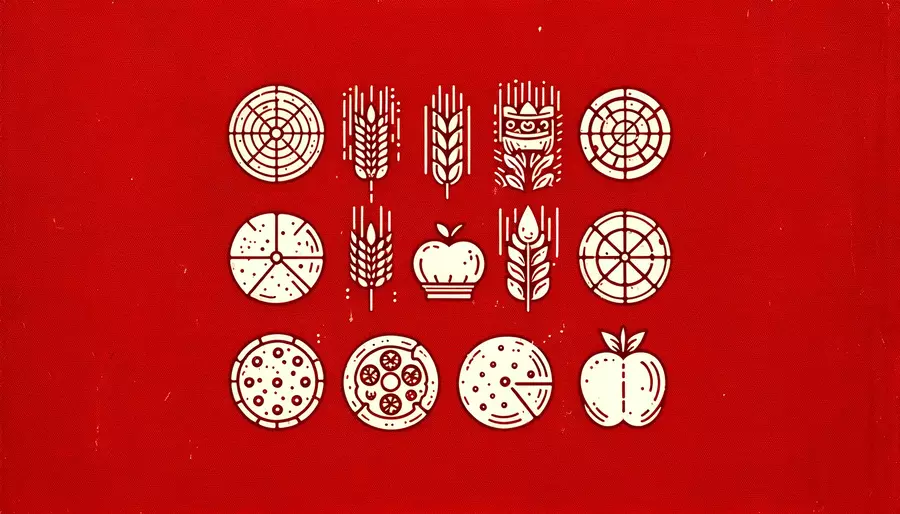Pizza: it’s a food steeped in tradition but with a versatility that sparks inspiration. Perhaps it’s one of the reasons pizza history dates back a millennia. We’ll tell the tale of the first pizza ever made to where pizza is today. So grab a slice, sit back, and enjoy!
Pizza History 101: Pizza’s Origin Story
If you ask anyone on a busy street, they can probably tell you pizza’s origin country is Italy. But can they tell you more about the first man who made a pizza or what inspired that first pie? Possibly not.
History of Pizza Crust
Pizza crust as we know it today began with the discovery of yeast in Ancient Egypt. Before this point, bread was unleavened—a wet dough cooked on a hot stone near an open flame. Yeast added air and texture to the dough, making it soft and light to eat.
Ancient Romans continued pizza’s history by further developing pizza crust through milled flour. They created different flours using types of farro. Combining milled wheat flour with salt, water, and herbs, they would knead it into a round loaf and cook it on the hearth. Romans also used these round, flatbreads to hold sauce-based dishes. It doesn’t resemble pizza as we know it, but it’s definitely pizza-adjacent.
From Where Does the Word Pizza Originate?
The first usage of the word “pizza” in history was around 1000 AD after the Lombards arrived in Italy. A German-derived word bizzo, or sometimes bizzen, meaning “bite” was getting pronounced pizzo by Italians.
The first documented instance of the word referring to a bakery item from the Abruzzo region indicated “pizis” or “pissas.” However, the first documentation of pizza in history in terms we recognize as pizza was in 1535 in Naples1. Poet Benedetto di Falco wrote the Neapolitans called “focaccia” pizza, and that was it—pizza was defined.
Naples has continued to change pizza history and tradition by adding olive oil to the crust instead of lard, seasoning with garlic and basil, and adding cheese.
The Final Main Ingredient: Tomato
At this point in pizza history, we have fancy bread. They may call it pizza, but it’s not the pizza we know and love today. Tasty, for sure, but without that tangy, zesty tomato, it’s just not pizza.
Tomatoes arrived in Italy in the 1600s, and tomato sauce was developed by simmering with salt and basil.
Tomatoes were dubbed “the poison apple” by European aristocracy and avoided2. The acidity of tomatoes reacted with the lead in the pewter plates used by wealthy Europeans, making them sick.
Many aristocrats died, so people blamed tomatoes because leaded plates weren’t known as problems at the time.
When pizza came into the picture, the crust came between tomatoes and pewter plates, drastically reducing the lead reaction and vastly improving the tomato’s reputation.
Because tomatoes initially had low demand, the prices were low, which made pizza a popular commodity on the street by street vendors. They could cut the slice to the size of a person’s budget.
When Was The First Pizza Delivery?
By the 1800s, we already had pizza, though the next hero of pizza history is credited with being there when pizza was invented. That’s an exaggeration. However, Chef Raffaele Esposito of Pizzeria Brandi3 could reasonably be the father of pizza delivery.
In 1889, Queen Margherita of Savoy and her husband, King Umberto I, were in Naples as part of a campaign to quiet growing unrest as part of the unification of Italy.
In those days, royalty ate the food of their home country regardless of their location. Rumor has it the Queen had grown tired of this and wanted to sample food from the local region.
Chef Esposito created three pizzas for the royals, one of which used the colors of the Italian flag in the form of tomatoes, mozzarella, and basil. Of course, the King and Queen wouldn’t go to the pizza, so Chef Esposito brought the pizza to them, resulting in the first pizza delivery.
Queen Margherita loved the tomato, basil, and mozzarella pizza so much that Chef Esposito named it after her. Today, we can still enjoy a Margherita Pizza on select menus.
Pizza History Arrives in the Modern-Day
Italian immigrants brought pizza to the New World between 1800 and 1920, when many began selling pizzas out of their homes in New York City. The first pizzeria4 in the U.S. was opened by Gennaro Lombardi in New York City in 1905, and many credit this restaurant with training many of the pizziolis who followed.
Pizza in the United States has evolved by region and city, with New York-style, Chicago-style, Detroit-style, Brooklyn-style, and Neapolitan pizza, just to name a few.
Pizza has evolved a lot in toppings, too. From traditional Italian styles to Mexican-based pizzas or themes like BBQ, cheeseburger, or even dessert, there’s a pizza for everyone and every flavor palette.
The way we order pizza has evolved, too. We’ve come a long way from face-to-face orders, calling for carryout, and traditional car delivery. Today, we can order through smartphone apps from anywhere and delivered to anywhere5. We can pay online and have our favorite pies delivered hot and ready to eat just the way we like them.
This is the Plaza Pizza® specialty, making and delivering traditional and flavorful pizzas in and around Newark and Heath, Ohio. For over 50 years, we’ve been making our signature crust pizzas that have become staples at family gatherings, celebrations, and special events.
We’re pleased to bring our ordering and payment technology into the modern day for our loyal customers to get their favorite Plaza Pizza® as easily and conveniently as ever! Order now to have a Plaza Pizza® favorite with our satisfying cracker-crunch crust brought right to your door!
1 Source: “The Incredible History of Pizza” lacucinaitaliana.com
2 Source: ”Why the Tomato was Feared in Europe for More Than 200 Years” Smithsonianmag.com
3 Source: “Pizza Margherita: History and Recipe” italymagazine.com
4 Source: “Slices of History: Great Moments in Pizza Innovation” business.time.com
5 Source: “Domino’s Rolls Out New Service to Deliver Pizzas to Places Like Beaches and Parks” CNBC.com

